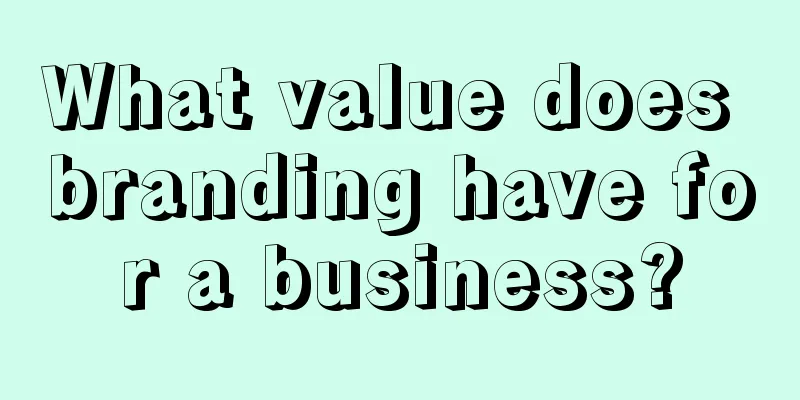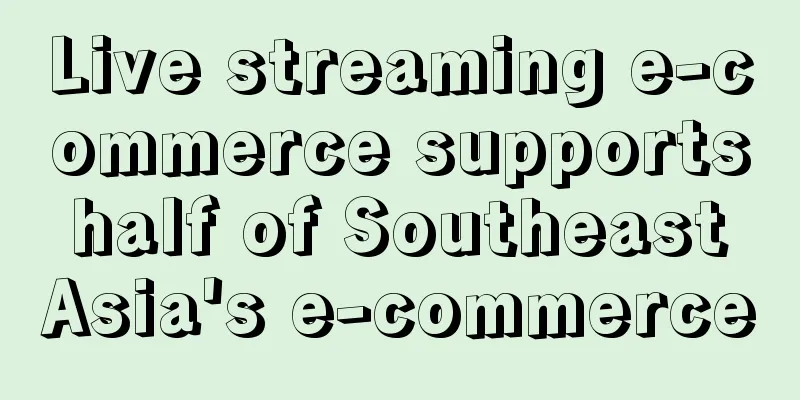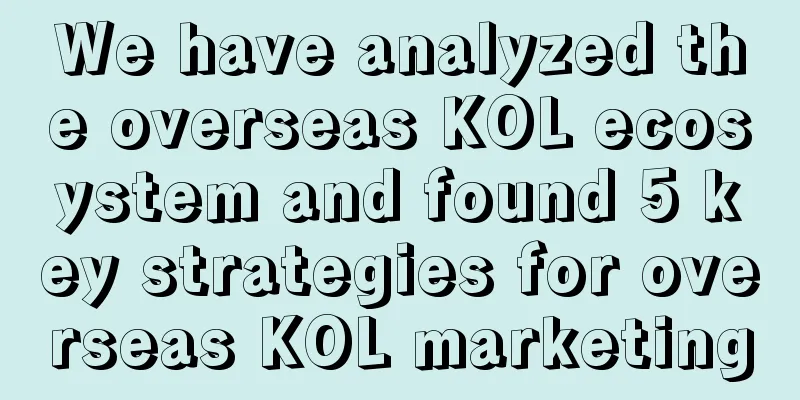What value does branding have for a business?

What value does branding have for a business? It’s funny that after loving something for more than ten years, I still have to keep thinking and discussing its value in the process. Yes, this proves that I am not as determined as I thought. This has also become the biggest source of pain for me over the past decade. The question of whether to work on branding full-time has troubled me for many years. The reason why this matter bothers me is that I have never been able to prove what the "actual value" behind this thing I love is. There are two common modes of doing things: One is to focus on something that already has "actual business value", give it meaning in the process, and then make it your mission. First find "business opportunities" and then look for "meaning". Many entrepreneurs follow this path. There is another way, which is to start from the "meaning" first, and then find the value and business model in the process. This way of doing things is idealistic, and I should belong to the latter, because I always feel that the meaning should be greater than the value. Fortunately, I am not a rigid and self-constrained person. After struggling for many years, I finally made some progress on the topic of "brand value". This is thanks to the entrepreneurs who trusted me the earliest since 2020. They gave the Relationship Brand Agency and myself an opportunity to enter the company at close range and study the value, tools and methods of the brand in the company from the perspective of the founder and CEO. Guanxi Brand Agency started from a high point. My first “client” was Mr. Tian Suning (a well-known entrepreneur, chairman of Broadband Capital, co-founder of AsiaInfo, known as the architect of China’s Internet. The words “Internet” and “Industrial Internet” are closely related to him at their origins). His understanding and cognition of the brand strengthened my ideal about “brand”. Through many discussions and practices with him, I saw the value of brand in the digital transformation of enterprises. After that, we successively served many well-known Chinese companies: the best camping brand "Mobi", the number one projection brand "LeTV", the air-source heat pump brand "FINNE", the lifestyle service brand "Markor Home", the artificial intelligence brand "Glint", the pride of the logistics industry "JD Logistics"... In the process of interacting with these outstanding companies and entrepreneurs, I ask myself this question every day: What value should a brand create for the company? For an enterprise, a brand should not just be a glorious, correct and empty intention (the same is true for students in the marketing and branding departments and third-party service providers who are engaged in branding), but should be the best tool and weapon for long-termists. From this perspective, the value of a brand should and must be clearly explained and quantified. My clients have given me great trust, which has given me the opportunity to explore the value and role of a company's brand as a strategic tool, cultural tool, marketing investment quantification tool, and communication tool. Now I will explain the actual value of the brand from the perspective of "tools": 1. Brand is a tool for enterprises to formulate strategies from an external perspectiveFor many companies, strategy is often a very "secret" thing. Several core executives will go to a beautiful place to "retreat" for a few days and get together to fully discuss. In some companies, the "boss" has the final say, so the strategy will be more about the boss sharing his thoughts and others thinking about how to implement it. Some companies like to discuss together, with several people talking about their own opinions. Larger companies also have strategic departments, and they need to gain insights into some content for decision-making every now and then. However, most companies’ strategic perspectives are often based on “me”: how I want to behave, what I want to do, our competitor XXX… Few companies think from the perspective of “how others see me”. The brand’s perspective is very peculiar. From the very beginning, it is an “other” perspective. “What do you want to be” and “how others see you” are two different things in strategy. “How others see you” can help solve the following problems at the strategic stage: Do other people need what you want? Is who you think you are the same as who others think you are? Should your internal strategy be coordinated with external “statements” and “ideas”? How does your strategy relate to people from all walks of life? There can be truth in this, or there can be a feint, there can be a high-profile spread, or there can be a low-key and roundabout one. Why do some strategies, which are so perfect, ultimately fail to succeed? Often, the strategy goes awry when it is implemented at the first level of management. A leadership team of 10 people may have eight different perceptions of a strategy. At this time, if we only look at it from the CEO's perspective, the strategy seems to have been completed (my manager and I definitely have the same perception), but from the perspective of other managers, the strategy is not yet clear (the more confident the CEO, the more serious this problem is). How about using brand as a strategic thinking tool? Here, others refer to both outsiders and insiders, including peers, customers, suppliers, partners, and employees within the team. 2. Optimize internal communication efficiency and solve cognitive alignment problemsMore and more companies have become "knowledge-based" companies (that is, they do not use fixed assets and standardized assembly lines as their main production methods, but use knowledge as their core assets, such as the Internet, artificial intelligence, content, finance, etc.). The biggest challenge for knowledge-based enterprises is management. A physical engineer sitting there does not mean that he is thinking about the code in spirit. N knowledge-based employees, communication and cognitive alignment will become a very large management cost for the enterprise. One-size-fits-all management fails to solve problems and instead stifles innovation. There is something called CIS in the brand, which is collectively called the identification system, including the "visual identification system", "behavioral identification system" and "concept identification system". After repeated practice in China, everyone has accepted the "visual identification system". "I want to build a brand, please help me design a LOGO", this is the most common cognitive acceptance. However, behaviors and concepts are ignored. A system for identifying concepts and behaviors will be integrated with "communication techniques, corporate culture actions, strategic introduction, and concept communication" to help knowledge workers improve their communication efficiency and become a cultural symbol within the company. Some people would say that this solution is what corporate culture should have done in the past, but the starting point of the cultural department is often unity and atmosphere. If it is not based on the overall organizational efficiency and internal brand recognition of the enterprise, it is difficult to achieve the effect. (I have talked about the trend of 3R integration before) 3. Brand review market investment to improve marketing input-output ratioThe biggest annoyance for marketers in the past two years is the “budget cuts.” Budget cuts are one of the three major ways to reduce costs and increase efficiency (layoffs, budget cuts, and digitalization), but in the process of cutting, I found that many marketing expenses were cut in a proportional way, and some were cut according to the expense amount. These methods can help companies save money quickly, but they will cause trouble in the future. Should marketing expenses be cut? How should they be cut? They should be cut according to the brand review method and the input-output ratio. Using brand as a yardstick for measurement and review, we can look at two things about past marketing investments: Are you doing things along the main axis of the brand, or doing things in a haphazard manner? Look at the input-output ratio of marketing from the perspective of brand benefits. Why does the input-output ratio of marketing refer to the brand? Because a large number of marketing activities are "losing money", as an "investment", the brand is the only result that can be settled. The most worrying thing is that some companies work hard on marketing for a long time, not only do they not make money, but also do not gain brand. 4. Cooperate with marketing to achieve quality and effectivenessMarketing is not a solitary battle, and revenue is not the only thing to focus on. The core elements of a brand include "profit" and "reasonable growth rate". When brand and marketing work together, the efficiency of marketing needs to consider growth rate and profit, and the company's own brand positioning and value chain management. At this time, it is not easy to go astray. For many ToB companies, a large number of front-end marketing and sales personnel ultimately focus on their own personal brands (whether intentionally or unintentionally), which is also a phenomenon that corporate brands need to be vigilant about. The more ToB companies are, the more they need to focus on branding instead of marketing (I have talked about the example of Japanese company Keyence). If a company does not pay attention to integrating its marketing with its brand, a large amount of marketing will lose its footing and become a hot "fireworks" or an action of "losing money but gaining publicity". When people set up a business, they want the business to bring influence. There are two kinds of influence: one is at the brain level, and the other is at the heart level. The influence at the brain level is achieved through a large number of images, repetitions, slogans, benefits, rituals, etc. Brand and market marketing is doing this, and the influence at the spiritual level requires companies and entrepreneurs to have a lot of mental energy to show it outward. This influence combined with the influence at the brain level, the effect is 1+1>2. 5. Thinking tools for enterprises to start againOne of my favorite comedians, Stephen Chow, once said: Why do you insist? Think about the beginning. This also applies to corporate transformation or the development of a second growth curve. Managers often don’t know where to start when organizing their thoughts. There are too many temptations in the second curve and it is difficult to make a judgment. Sometimes it is very helpful to find the original mission and vision of the company and to truly clarify one’s own values. What I am talking about is not the slogans posted on the wall. Sometimes CEOs never look at them seriously. What I am talking about is to really think clearly: Why do I want to start such a company? Does the world really need such a company? Does my family really need such a company? What do I want to express with it? The above five points are what I have become increasingly clear about in practice. Following these values, we develop more content, tools, and consulting methods to help companies and entrepreneurs who trust brands and trust us in a down-to-earth manner. Author: Li Qian Source: WeChat public account "Li Qian talks about brands (ID: liaotian78)" |
>>: The "sons" in the live broadcast room cheated my father out of 150,000 yuan
Recommend
Who will bear the THC cost? In what cases will the customer bear the cost?
Nowadays, more and more people choose to buy goods...
It’s not Pinduoduo that defeats Alibaba!
Pinduoduo's market value surpassed Alibaba? Wh...
What are the essential steps for Amazon beginners?
Amazon is the first stop for most people who trave...
Less than a year after testing the waters, ByteDance shut down multiple interactive drama businesses
Due to business adjustments, several exploration I...
How long does it take for the refund to be credited to my account after it is shown as a successful refund? What are the reasons for the refund?
Now when you buy goods online, if you are not sati...
How can I leave a review on Amazon without getting rejected? How long does it take for the review to be displayed?
There are many rules on Amazon's cross-border ...
What are the precautions for listing products on Shopee? How to do it well?
After opening a store on Shopee, merchants need to...
How much does the average Amazon seller make in a year? What are the costs?
I know a little bit about Amazon at home. Many mer...
Is cross-border e-commerce b2b considered wholesale? Which platforms are popular?
In recent years, cross-border e-commerce has been ...
Shopee's new look activates Shopee Barokah
Shopee recently launched Shopee Barokah with a new...
How can brands create targeted content for the back-funnel population?
This article mainly introduces a marketing strateg...
Douyin's food delivery business shrinks and is transferred from local life to e-commerce department
Douyin and Kuaishou, two short video giants, are t...
How to find the hot-selling plus-size women's clothing from Shein? How is Shein women's clothing?
Shein is a popular fashion e-commerce platform wit...
Weibo loses its big V vest
Recently, there is news on the Internet that Weibo...
Will Amazon's 7-day promotional prices affect the next time? What are the rules?
When shopping on Amazon, a cross-border e-commerce...









